Toxicity Risk Assessment Due to Particulate Matter Pollution from Regional Health Data: Case Study from Central Romania
Abstract
1. Introduction
2. Study Area and Data Sets
3. Methods and Methodologies
4. Results and Discussion
5. Conclusions, Limitations, and Future Directions
Author Contributions
Funding
Informed Consent Statement
Data Availability Statement
Conflicts of Interest
References
- Thurston, G.D.; Burnett, R.T.; Turner, M.C.; Shi, Y.; Krewski, D.; Lall, R.; Ito, K.; Jerrett, M.; Gapstur, S.M.; Diver, W.R.; et al. Ischemic Heart Disease Mortality and Long-Term Exposure to Source-Related Components of U.S. Fine Particle Air Pollution. Environ. Health Perspect. 2016, 124, 785–794. [Google Scholar] [CrossRef]
- Maftei, C.; Muntean, R.; Poinareanu, I. The Impact of Air Pollution on Pulmonary Diseases: A Case Study from Brasov County, Romania. Atmosphere 2022, 13, 902. [Google Scholar] [CrossRef]
- World Health Organization (Ed.) Air Quality Guidelines: Global Update 2005: Particulate Matter, Ozone, Nitrogen Dioxide, and Sulfur Dioxide; World Health Organization: Copenhagen, Denmark, 2006; ISBN 978-92-890-2192-0. [Google Scholar]
- Combes, A.; Franchineau, G. Fine Particle Environmental Pollution and Cardiovascular Diseases. Metabolism 2019, 100, 153944. [Google Scholar] [CrossRef] [PubMed]
- Lu, Y.; Lin, S.; Fatmi, Z.; Malashock, D.; Hussain, M.M.; Siddique, A.; Carpenter, D.O.; Lin, Z.; Khwaja, H.A. Assessing the Association between Fine Particulate Matter (PM2.5) Constituents and Cardiovascular Diseases in a Mega-City of Pakistan. Environ. Pollut. 2019, 252, 1412–1422. [Google Scholar] [CrossRef] [PubMed]
- Zhang, W.; Lin, S.; Hopke, P.K.; Thurston, S.W.; van Wijngaarden, E.; Croft, D.; Squizzato, S.; Masiol, M.; Rich, D.Q. Triggering of Cardiovascular Hospital Admissions by Fine Particle Concentrations in New York State: Before, during, and after Implementation of Multiple Environmental Policies and a Recession. Environ. Pollut. 2018, 242, 1404–1416. [Google Scholar] [CrossRef] [PubMed]
- Kim, S.Y.; Kim, S.H.; Wee, J.H.; Min, C.; Han, S.-M.; Kim, S.; Choi, H.G. Short- and Long-Term Exposure to Air Pollution Increases the Risk of Ischemic Heart Disease. Sci. Rep. 2021, 11, 5108. [Google Scholar] [CrossRef] [PubMed]
- Pope, C.A.; Muhlestein, J.B.; May, H.T.; Renlund, D.G.; Anderson, J.L.; Horne, B.D. Ischemic Heart Disease Events Triggered by Short-Term Exposure to Fine Particulate Air Pollution. Circulation 2006, 114, 2443–2448. [Google Scholar] [CrossRef] [PubMed]
- Orru, H.; Maasikmets, M.; Lai, T.; Tamm, T.; Kaasik, M.; Kimmel, V.; Orru, K.; Merisalu, E.; Forsberg, B. Health Impacts of Particulate Matter in Five Major Estonian Towns: Main Sources of Exposure and Local Differences. Air Qual. Atmos. Health 2011, 4, 247–258. [Google Scholar] [CrossRef]
- Anenberg, S.C.; Horowitz, L.W.; Tong, D.Q.; West, J.J. An Estimate of the Global Burden of Anthropogenic Ozone and Fine Particulate Matter on Premature Human Mortality Using Atmospheric Modeling. Environ. Health Perspect. 2010, 118, 1189–1195. [Google Scholar] [CrossRef]
- Pascal, M.; Corso, M.; Chanel, O.; Declercq, C.; Badaloni, C.; Cesaroni, G.; Henschel, S.; Meister, K.; Haluza, D.; Martin-Olmedo, P.; et al. Assessing the Public Health Impacts of Urban Air Pollution in 25 European Cities: Results of the Aphekom Project. Sci. Total Environ. 2013, 449, 390–400. [Google Scholar] [CrossRef]
- Bodor, K.; Szép, R.; Bodor, Z. The Human Health Risk Assessment of Particulate Air Pollution (PM2.5 and PM10) in Romania. Toxicol. Rep. 2022, 9, 556–562. [Google Scholar] [CrossRef] [PubMed]
- Burnett, R.; Ma, R.; Jerrett, M.; Goldberg, M.S.; Cakmak, S.; Pope, C.A.; Krewski, D. The Spatial Association between Community Air Pollution and Mortality: A New Method of Analyzing Correlated Geographic Cohort Data. Environ. Health Perspect. 2001, 109, 375–380. [Google Scholar] [PubMed]
- Ostro, B. Outdoor Air Pollution: Assessing the Environmental Burden of Disease at National and Local Levels. In Environmental Burden of Disease Series; World Health Organization: Geneva, Switzerland, 2004; Volume 5, ISBN 9241591463. [Google Scholar]
- Pope, C.A.; Burnett, R.T.; Thun, M.J.; Calle, E.E.; Krewski, D.; Ito, K.; Thurston, G.D. Lung Cancer, Cardiopulmonary Mortality, and Long-Term Exposure to Fine Particulate Air Pollution. JAMA 2002, 287, 1132–1141. [Google Scholar] [CrossRef] [PubMed]
- Pope, C.A.; Burnett, R.T.; Thurston, G.D.; Thun, M.J.; Calle, E.E.; Krewski, D.; Godleski, J.J. Cardiovascular Mortality and Long-Term Exposure to Particulate Air Pollution. Circulation 2004, 109, 71–77. [Google Scholar] [CrossRef] [PubMed]
- Anderson, H.R.; Atkinson, R.W.; Peacock, J.L.; Marston, L.; Konstantinou, K.; World Health Organization. Meta-Analysis of Time-Series Studies and Panel Studies of Particulate Matter (PM) and Ozone (O3); Report of a WHO Task Group; World Health Organization: Copenhagen, Denmark, 2004. [Google Scholar]
- Aphekom Group; Chanel, O.; Perez, L.; Künzli, N.; Medina, S. The Hidden Economic Burden of Air Pollution-Related Morbidity: Evidence from the Aphekom Project. Eur. J. Health Econ. 2016, 17, 1101–1115. [Google Scholar] [CrossRef]
- Vaseashta, A. (Ed.) Life Cycle Analysis of Nanoparticles: Risk, Assessment, and Sustainability; Destech Publications, Inc: Lancaster, PA, USA, 2015; ISBN 978-1-60595-023-5. [Google Scholar]
- CalitateAer. Available online: https://www.calitateaer.ro/ (accessed on 8 November 2023).
- European Parliament Directive 2008/50/CE 2008. Available online: https://www.eea.europa.eu/policy-documents/directive-2008-50-ec-of (accessed on 11 November 2023).
- Directive 2004/107/EC—European Environment Agency. Available online: https://www.eea.europa.eu/policy-documents/directive-2004-107-ec (accessed on 9 November 2023).
- World Health Organization. Review of Evidence on Health Aspects of Air Pollution: REVIHAAP Project: Technical Report; World Health Organization. Regional Office for Europe: Copenhagen, Denmark, 2021. [Google Scholar]
- Aphekom.Org. Available online: http://aphekom.org/web/aphekom.org/home (accessed on 9 November 2023).
- Levei, L.; Hoaghia, M.-A.; Roman, M.; Marmureanu, L.; Moisa, C.; Levei, E.A.; Ozunu, A.; Cadar, O. Temporal Trend of PM10 and Associated Human Health Risk over the Past Decade in Cluj-Napoca City, Romania. Appl. Sci. 2020, 10, 5331. [Google Scholar] [CrossRef]
- Stoian, I.M.; Parvu, S.; Neamtu, A.; Calota, V.; Voinoiu, A.; Pistol, A.; Cucuiu, R.; Minca, D.G.; Davila, C. PM10 and NO2 Air Pollution and Evolution of COVID-19 Cases in Romania. Maedica 2022, 17, 777–784. [Google Scholar]
- Park, S.K. Seasonal Variations of Fine Particulate Matter and Mortality Rate in Seoul, Korea with a Focus on the Short-Term Impact of Meteorological Extremes on Human Health. Atmosphere 2021, 12, 151. [Google Scholar] [CrossRef]
- Popescu, L.L.; Popescu, R.S.; Catalina, T. Indoor Particle’s Pollution in Bucharest, Romania. Toxics 2022, 10, 757. [Google Scholar] [CrossRef] [PubMed]
- COVID-19 Excess Mortality Collaborators. Estimating excess mortality due to the COVID-19 pandemic: A systematic analysis of COVID-19-related mortality, 2020–2021. Lancet 2022, 399, 1513–1536. [Google Scholar] [CrossRef]
- Vidal-Perez, R.; Brandão, M.; Pazdernik, M.; Kresoja, K.-P.; Carpenito, M.; Maeda, S.; Casado-Arroyo, R.; Muscoli, S.; Pöss, J.; Fontes-Carvalho, R.; et al. Cardiovascular disease, and COVID-19, a deadly combination: A review about direct and indirect impact of a pandemic. World J. Clin. Cases 2022, 10, 9556–9572. [Google Scholar] [CrossRef]
- Cohen, P.; Potchter, O.; Schnell, I. The impact of an urban park on air pollution and noise levels in the Mediterranean city of Tel-Aviv, Israel. Environ. Pollut. 2014, 195, 73–83. [Google Scholar] [CrossRef]
- Vaseashta, A.; Maftei, C.; Radu, D. Exploring Disruption Trajectories From COVID-19 on Education and the Impact of Policies: Lessons Learned and Path Forward. In Transformation and Efficiency Enhancement of Public Utilities Systems: Multidimensional Aspects and Perspectives; Gjorchev, J., Malcheski, S., Rađenović, T., Vasović, D., Živković, S., Eds.; IGI Global: Hershey, PA, USA, 2023; pp. 314–340. [Google Scholar] [CrossRef]
- Baldwin, J.; Noorali, S.; Vaseashta, A. Biology and Behavior of Severe Acute Respiratory Syndrome Coronavirus Contagion with Emphasis on Treatment Strategies, Risk Assessment, and Resilience. COVID 2023, 3, 1259–1303. [Google Scholar] [CrossRef]
- Abe, K.C.; Rodrigues, M.A.; Miraglia, S.G.E.K. Health impact assessment of air pollution in Lisbon, Portugal. J. Air Waste Manag. Assoc. 2022, 72, 1307–1315. [Google Scholar] [CrossRef] [PubMed]
- Kowalski, M.; Kowalska, K.; Kowalska, M. Health benefits related to the reduction of PM concentration in ambient air, Silesian Voivodeship, Poland. Int. J. Occup. Med. Environ. Health 2015, 29, 209–217. [Google Scholar] [CrossRef] [PubMed][Green Version]
- Egerstrom, N.; Rojas-Rueda, D.; Martuzzi, M.; Jalaludin, B.; Nieuwenhuijsen, M.; So, R.; Lim, Y.-H.; Loft, S.; Andersen, Z.J.; Cole-Hunter, T. Health and economic benefits of meeting WHO air quality guidelines, Western Pacific Region. Bull. World Health Organ. 2023, 101, 130–139. [Google Scholar] [CrossRef] [PubMed]
- Boboc, C. Cultural Tourism in Central Region of Romania. Available online: https://www.proquest.com/openview/ce3e67fa4c6b5c90e8592f005f7215d1/1?pq-origsite=gscholar&cbl=2036059 (accessed on 23 September 2023).
- Mitrano, D.M.; Wick, P.; Nowack, B. Placing Nanoplastics in the Context of Global Plastic Pollution. Nat. Nanotechnol. 2021, 16, 491–500. [Google Scholar] [CrossRef] [PubMed]
- Stabnikova, O.; Stabnikov, V.; Marinin, A.; Klavins, M.; Klavins, L.; Vaseashta, A. Microbial Life on the Surface of Microplastics in Natural Waters. Appl. Sci. 2021, 11, 11692. [Google Scholar] [CrossRef]
- Vaseashta, A.; Ivanov, V.; Stabnikov, V.; Marinin, A. Environmental Safety and Security Investigations of Neustonic Microplastic Aggregates Near Water-Air Interphase. Pol. J. Environ. Stud. 2021, 30, 3457–3469. [Google Scholar] [CrossRef]
- Vaseashta, A.; Gevorgyan, G.; Kavaz, D.; Ivanov, O.; Jawaid, M.; Vasović, D. Exposome, Biomonitoring, Assessment, and Data Analytics to Quantify Universal Water Quality. In Water Safety, Security and Sustainability; Advanced Sciences and Technologies for Security Applications; Vaseashta, A., Maftei, C., Eds.; Springer: Cham, Switzerland, 2021. [Google Scholar] [CrossRef]


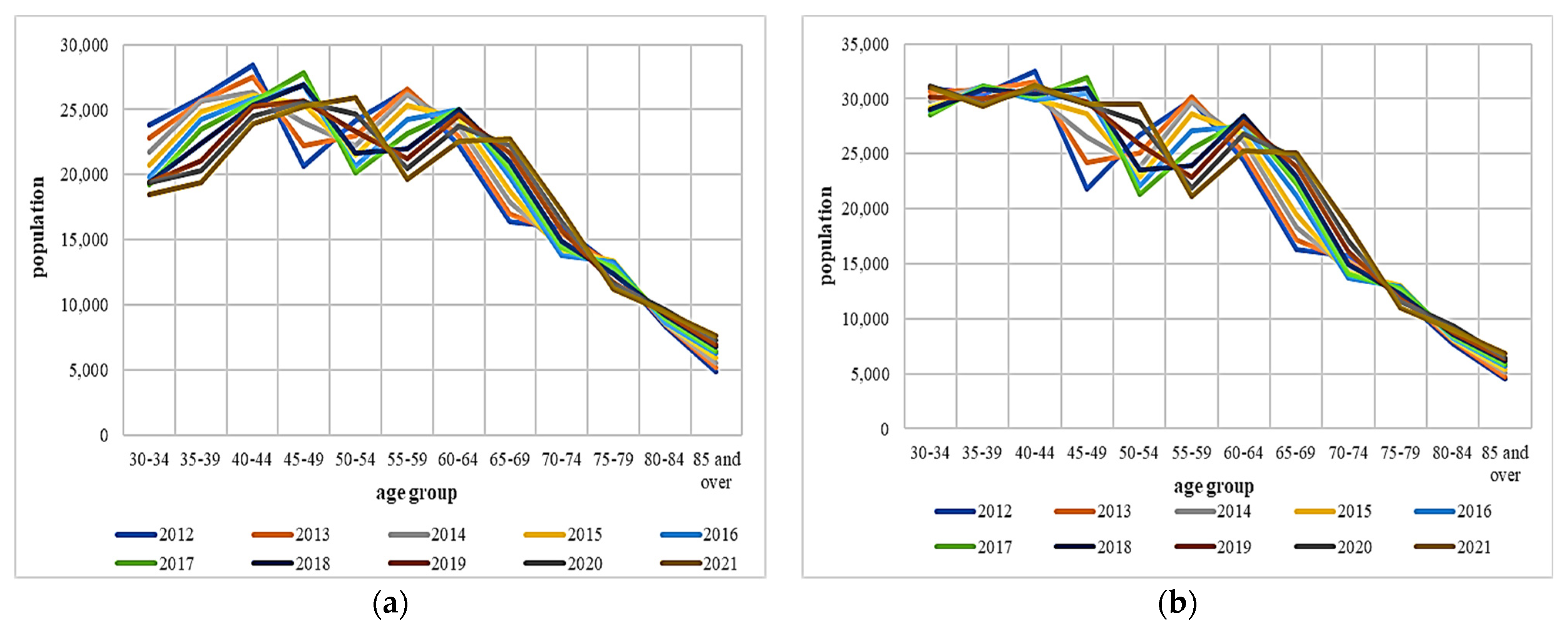
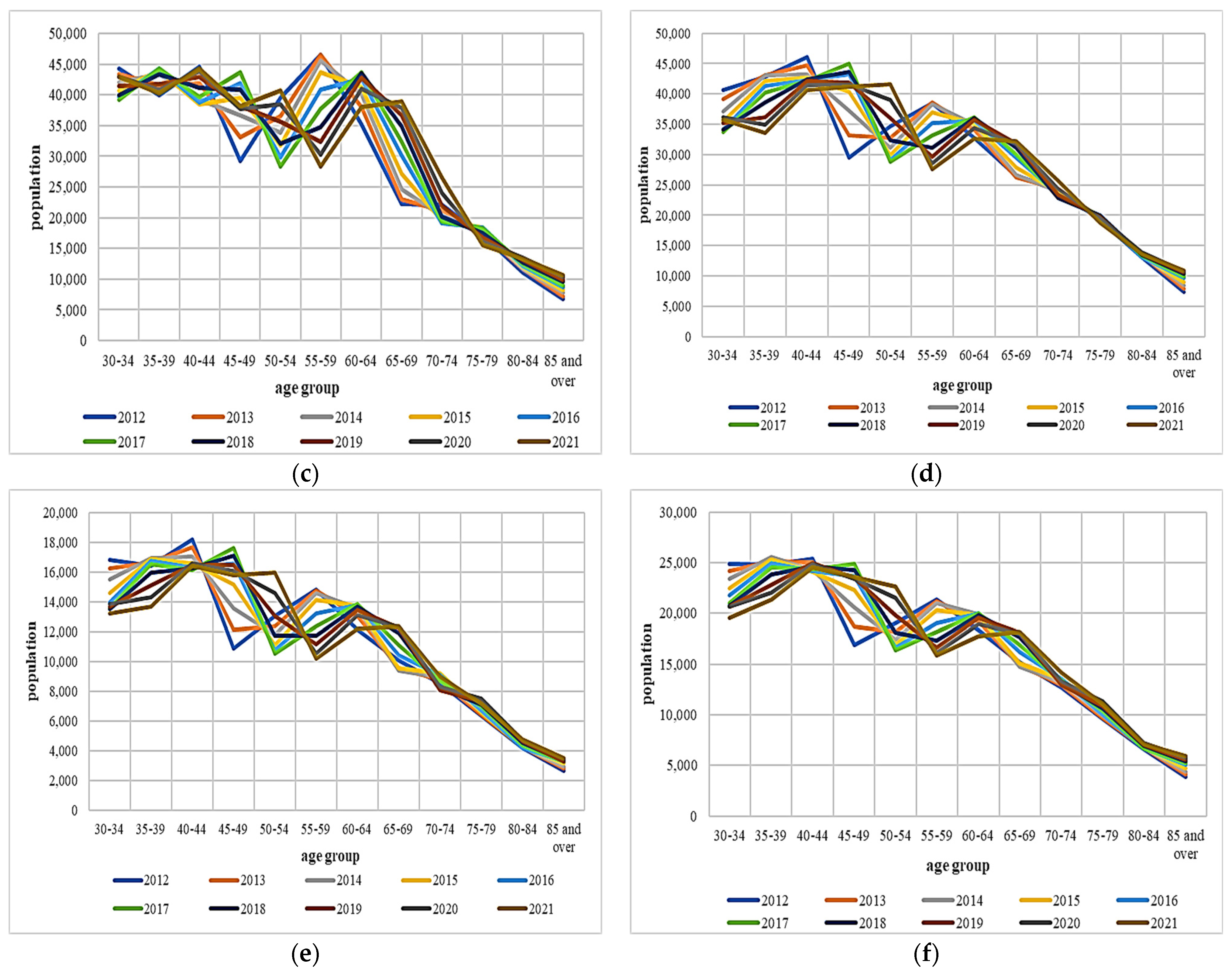
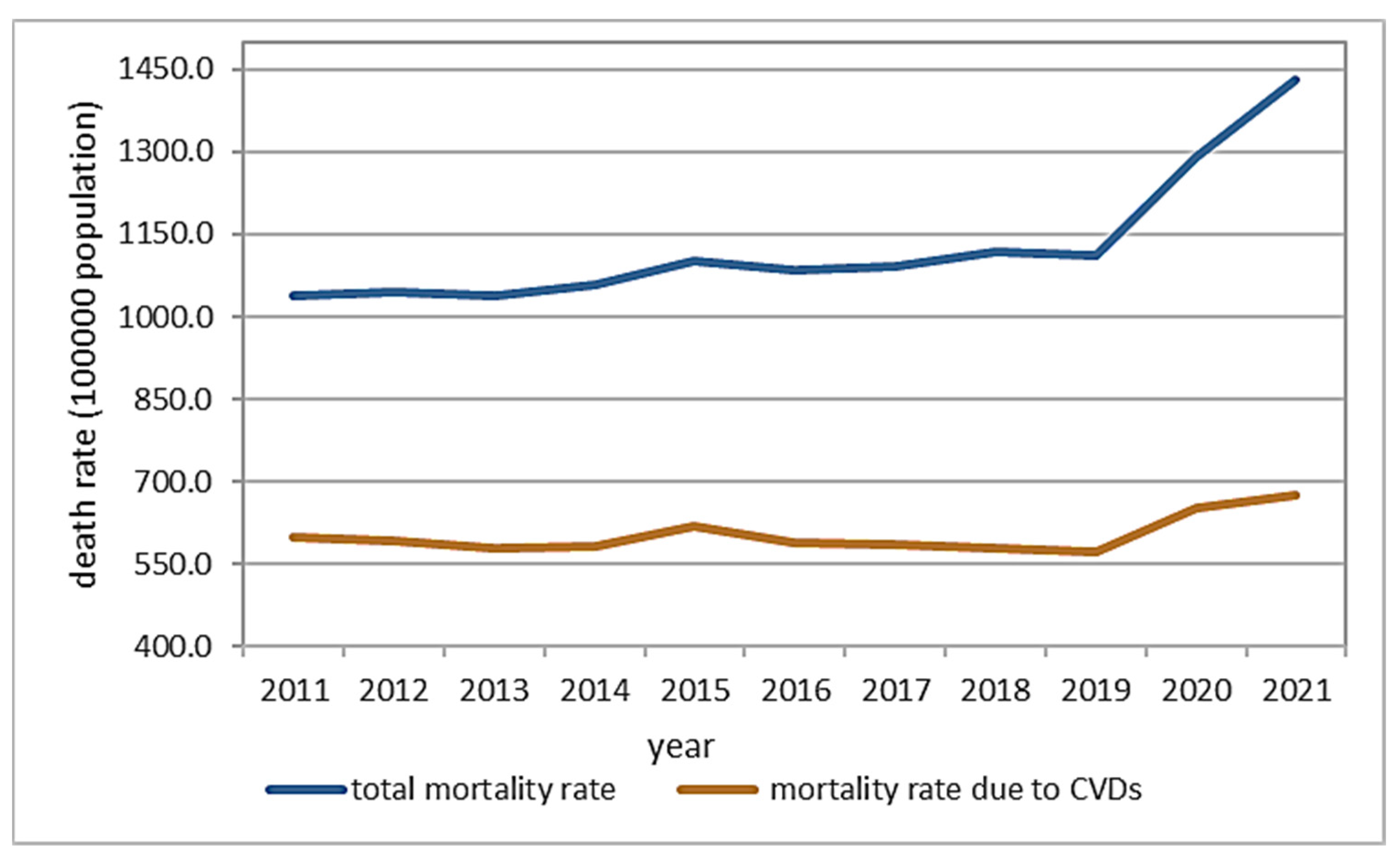

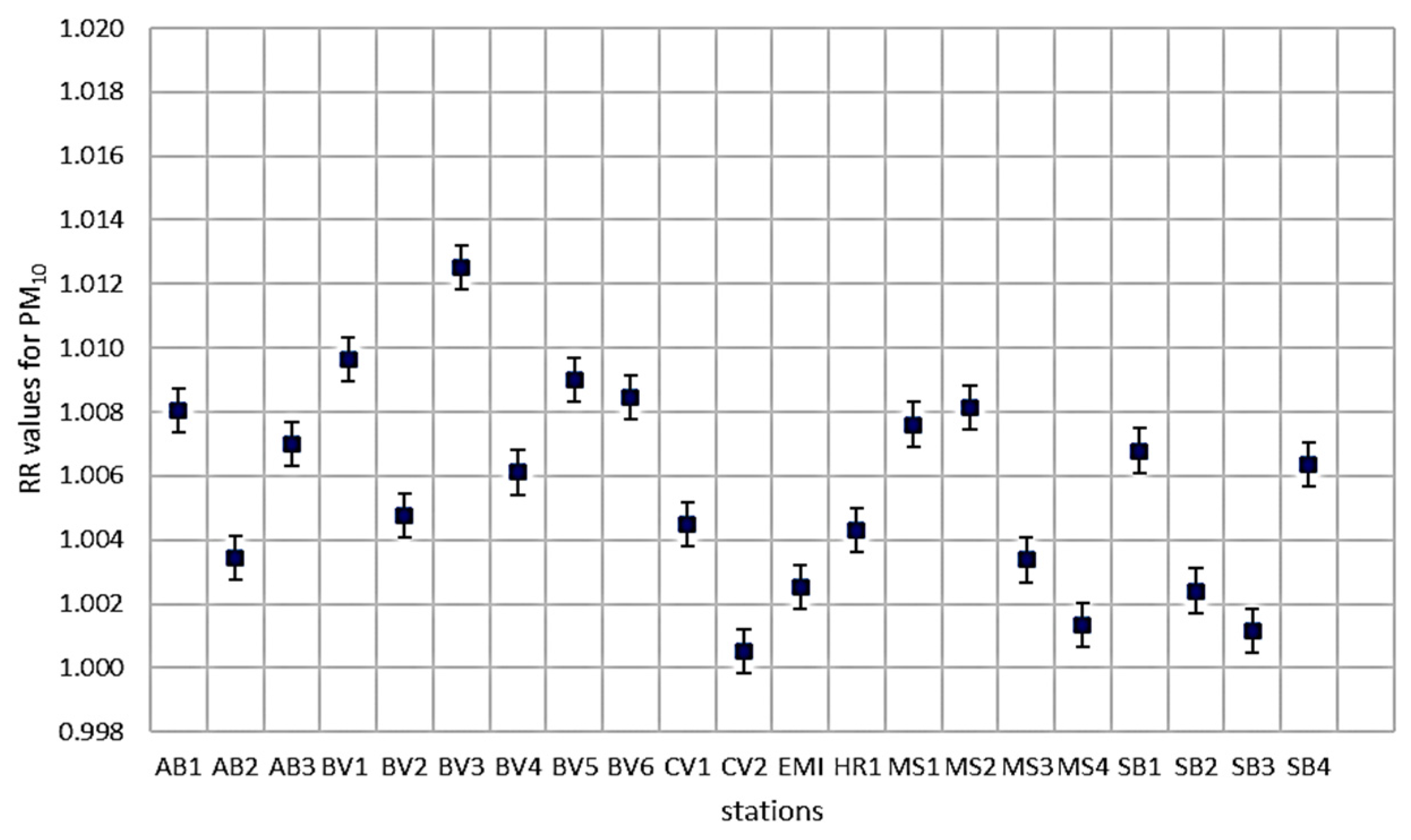
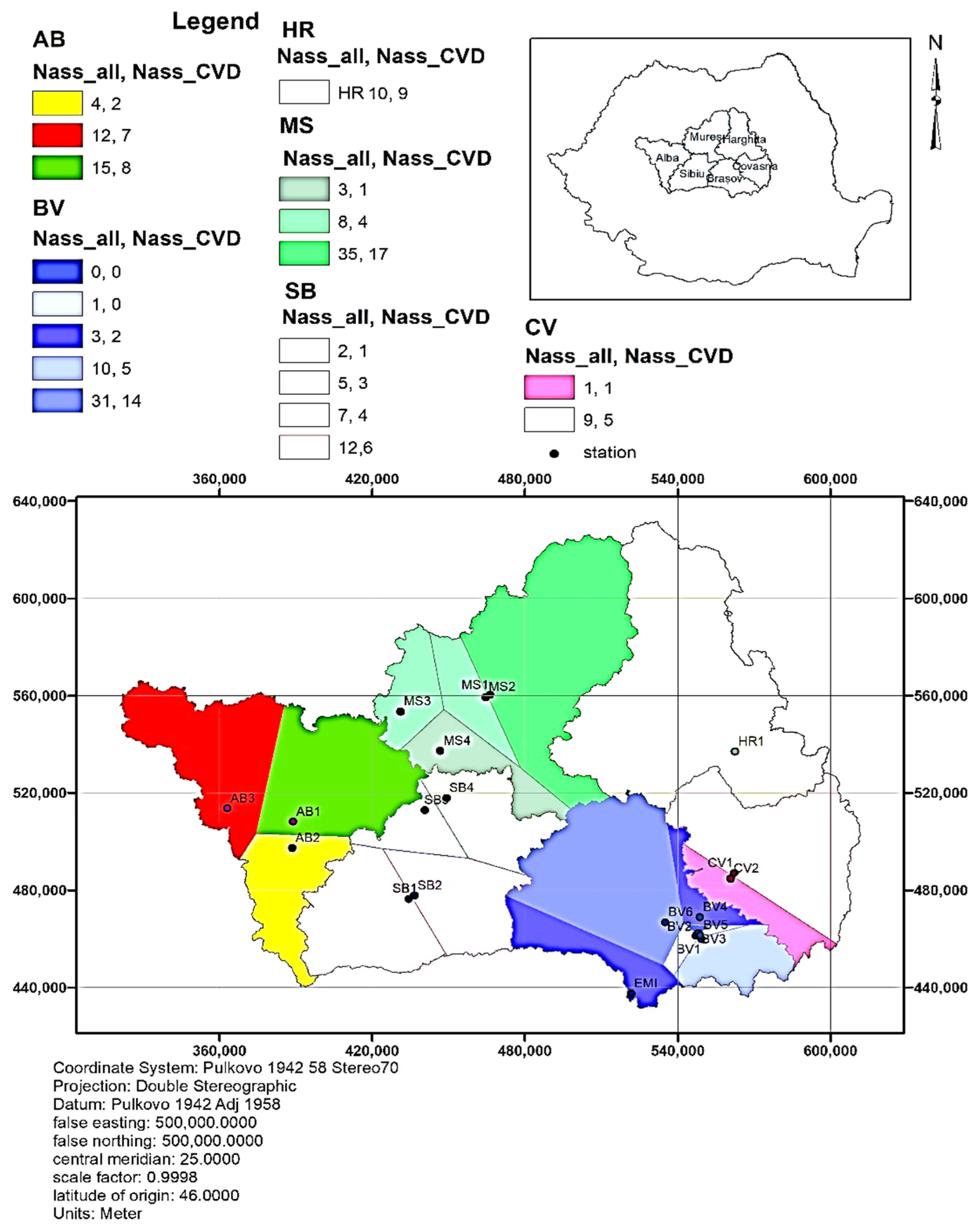

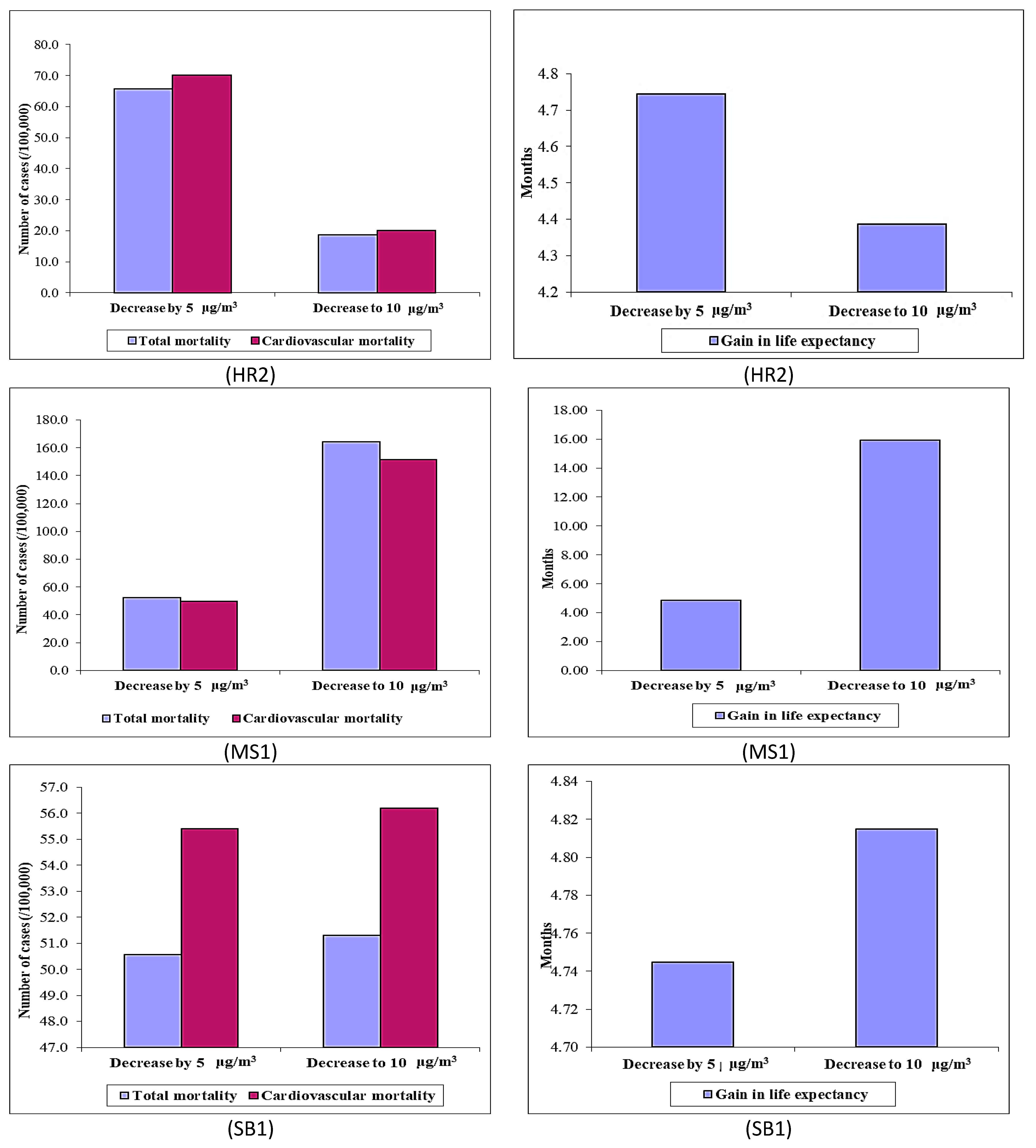
| No. | County/Station Indicative | Village | Type | Elevation (m) | PM2.5 (Y/N) |
|---|---|---|---|---|---|
| Alba | |||||
| 1 | AB1 | Alba Iulia | urban | 246 | N |
| 2 | AB2 | Sebes | urban | 256 | N |
| 3 | AB3 | Zlatna | urban | 450 | N |
| Sibiu | |||||
| 4 | SB1 | Sibiu | urban | 430 | Y |
| 5 | SB2 | Sibiu | industrial | 402 | N |
| 6 | SB3 | Copsa Mica | industrial | 285 | N |
| 7 | SB4 | Medias | industrial | 320 | N |
| Brasov | |||||
| 8 | BV1 | Brasov | urban | 593 | N |
| 9 | BV2 | Brasov | urban | 593 | Y |
| 10 | BV3 | Brasov | urban | 593 | N |
| 11 | BV4 | Sanpetru | suburban | 560 | N |
| 12 | BV5 | Brasov | industrial | 593 | N |
| 13 | BV6 | Codlea | urban | 567 | Y (Since 2022) |
| 14 | EMI | Fundata | suburban | 1350 | Y (Since 2022) |
| Mures | |||||
| 15 | MS1 | Targu Mures | urban | 329 | Y |
| 16 | MS2 | Targu Mures | suburban | 304 | N |
| 17 | MS3 | Ludus | suburban | 270 | N |
| 18 | MS4 | Tarnaveni | suburban | 284 | N |
| Covasna | |||||
| 19 | CV1 | Sf Gheorghe | rural | 522 | N |
| 20 | CV2 | Sf. Gheorghe | urban | 563 | N |
| Harghita | |||||
| 21 | HR1 | Miercurea Ciuc | industrial | 710 | Y (Since 2017) |
| 22 | HR2 | Miercurea Ciuc | urban | 689 | Y (Since 2019) |
| PM2.5 μg/m3 | PM10 μg/m3 | ||
|---|---|---|---|
| Romanian legislation and EU standards | annual average | 25 (20 until (and after) 2020) | 40 |
| 24 h average | not regulated | 50 | |
| WHO limits [3] 2005 | annual average | 10 | 20 |
| 24 h average | 25 | 50 | |
| WHO limits [23] 2021 | annual average | 5 | 15 |
| 24 h average | 15 | 45 |
| (a) | ||||||||||||||||||||||||||||||||||||||
|---|---|---|---|---|---|---|---|---|---|---|---|---|---|---|---|---|---|---|---|---|---|---|---|---|---|---|---|---|---|---|---|---|---|---|---|---|---|---|
| PM10 (2011–2021)—Statistics | ||||||||||||||||||||||||||||||||||||||
| No. crt. | Station Indicative | No. obsv. | Min. μg/m3 | Max. μg/m3 | Mean μg/m3 | StD. μg/m3 | 5th μg/m3 | 95th μg/m3 | No. of Days over Limit of 50 μg/m3 | No. of Days over Limit of 45 μg/m3 | No. of Year over Limit of 40 μg/m3 | No. of Year over Limit of 20 μg/m3 | No. of Year over Limit of 15 μg/m3 | |||||||||||||||||||||||||
| no | % | no | % | no | % | no | % | no | % | |||||||||||||||||||||||||||||
| 1 | 2 | 3 | 4 | 5 | 6 | 7 | 8 | 9 | 10 | 11 | 12 | 13 | 14 | 15 | 16 | |||||||||||||||||||||||
| Alba | ||||||||||||||||||||||||||||||||||||||
| 1 | AB1 | 3769 | 0.01 | 104.84 | 23.36 | 13.73 | 8.18 | 49.42 | 110 | 3% | 361 | 10% | 0 | 0 | 9 | 82% | 11 | 100% | ||||||||||||||||||||
| 2 | AB2 | 982 | 2.88 | 120.41 | 30.95 | 17.80 | 11.30 | 66.86 | 107 | 11% | 179 | 18% | 0 | 0 | 3 | 100% | 3 | 100% | ||||||||||||||||||||
| 3 | AB3 | 3601 | 0.38 | 74.03 | 20.92 | 12.24 | 7.45 | 47.87 | 51 | 1% | 241 | 7% | 0 | 0 | 6 | 55% | 11 | 100% | ||||||||||||||||||||
| Sibiu | ||||||||||||||||||||||||||||||||||||||
| 4 | SB1 | 3206 | 0.73 | 109 | 21.57 | 12.42 | 7.27 | 45.42 | 98 | 3.06% | 171 | 5% | 0 | 0 | 6 | 60.00% | 10 | 100.00% | ||||||||||||||||||||
| 5 | SB2 | 2813 | 0.27 | 102.97 | 12.75 | 11.69 | 1.58 | 35.56 | 49 | 1.74% | 75 | 3% | 0 | 0 | 2 | 18.18% | 3 | 27.27% | ||||||||||||||||||||
| 6 | SB3 | 3051 | 0.24 | 112.64 | 20.87 | 13.73 | 4.72 | 47.24 | 104 | 3.41% | 214 | 7% | 0 | 0 | 6 | 54.55% | 8 | 72.73% | ||||||||||||||||||||
| 7 | SB4 | 2845 | 1.27 | 125.36 | 22.74 | 15.14 | 5.45 | 49.86 | 142 | 4.99% | 272 | 10% | 0 | 0 | 7 | 70.00% | 9 | 90.00% | ||||||||||||||||||||
| Brasov | ||||||||||||||||||||||||||||||||||||||
| 8 | BV1 | 3557 | 1.82 | 179.23 | 26.09 | 16.87 | 7.63 | 55.81 | 252 | 7.08% | 369 | 10% | 0 | 11 | 100.00% | 11 | 100.00% | |||||||||||||||||||||
| 9 | BV2 | 1649 | 2.36 | 255.93 | 27.41 | 20.83 | 8.18 | 57.40 | 107 | 6.49% | 181 | 11% | 0 | 5 | 100.00% | 5 | 100.00% | |||||||||||||||||||||
| 10 | BV3 | 3710 | 1.27 | 216.48 | 30.81 | 19.37 | 10.22 | 64.14 | 368 | 9.92% | 589 | 16% | 1 | 0.02 | 11 | 100.00% | 11 | 100.00% | ||||||||||||||||||||
| 11 | BV4 | 3151 | 0.36 | 200.95 | 21.16 | 17.48 | 4.54 | 49.33 | 153 | 4.86% | 205 | 7% | 0 | 7 | 70.00% | 10 | 100.00% | |||||||||||||||||||||
| 12 | BV5 | 1167 | 0.43 | 272.09 | 22.80 | 22.65 | 5.63 | 56.21 | 74 | 6.34% | 91 | 8% | 2 | 0.17 | 6 | 75.00% | 8 | 100.00% | ||||||||||||||||||||
| 13 | BV6 | 249 | 5.09 | 80.36 | 22.06 | 13.01 | 7.73 | 46.68 | 11 | 4.42% | 16 | 6% | 0 | 1 | 100.00% | 1 | 100.00% | |||||||||||||||||||||
| 14 | EMI | 726 | 0.73 | 66.86 | 9.48 | 8.00 | 1.45 | 23.89 | 4 | 0.55% | 5 | 1% | 0 | 0 | 0.00% | 0 | 0.00% | |||||||||||||||||||||
| Mures | ||||||||||||||||||||||||||||||||||||||
| 15 | MS1 | 2126 | 0.89 | 154.32 | 24.10 | 17.80 | 6.22 | 58.44 | 170 | 8.00% | 231 | 11% | 0 | 8 | 72.73% | 9 | 81.82% | |||||||||||||||||||||
| 16 | MS2 | 2438 | 0.52 | 263.71 | 25.19 | 18.98 | 5.79 | 60.47 | 210 | 8.61% | 283 | 12% | 0 | 8 | 72.73% | 9 | 81.82% | |||||||||||||||||||||
| 17 | MS3 | 881 | 2.05 | 110.36 | 22.43 | 13.21 | 7.26 | 48.39 | 40 | 4.54% | 54 | 6% | 0 | 3 | 75.00% | 4 | 100.00% | |||||||||||||||||||||
| 18 | MS4 | 2133 | 0.04 | 95.39 | 10.59 | 11.26 | 1.60 | 32.29 | 41 | 1.92% | 57 | 3% | 0 | 0 | 0.00% | 3 | 33.33% | |||||||||||||||||||||
| Covasna | ||||||||||||||||||||||||||||||||||||||
| 19 | CV1 | 2484 | 0.09 | 141.16 | 18.93 | 13.19 | 4.62 | 43.67 | 88 | 3.54% | 118 | 5% | 0 | 5 | 45.45% | 8 | 72.73% | |||||||||||||||||||||
| 20 | CV2 | 204 | 1.63 | 75.25 | 21.85 | 19.7 | 5.71 | 41.04 | 6 | 2.94% | 8 | 4% | 0 | 0 | 0.00% | 1 | 100.00% | |||||||||||||||||||||
| Harghita | ||||||||||||||||||||||||||||||||||||||
| 21 | HR1 | 3225 | 0.18 | 221.6 | 16.94 | 19.05 | 2.36 | 51.02 | 164 | 5% | 197 | 6% | 0 | 2 | 18% | 8 | 73% | |||||||||||||||||||||
| 22 | HR2 | - | - | - | - | - | - | - | - | - | - | - | - | - | - | - | - | |||||||||||||||||||||
| (b) | ||||||||||||||||||||||||||||||||||||||
| Station Indicative | PM2.5 (2011–2021)—Statistics | |||||||||||||||||||||||||||||||||||||
| No. obsv. | Min μg/m3 | Max μg/m3 | Mean μg/m3 | StD. μg/m3 | 5th μg/m3 | 95th μg/m3 | No. of Year over Limit of 25 μg/m3 | No. of Year over Limit of 20 μg/m3 | No. of Year over Limit of 10 μg/m3 | No. of Year over Limit of 5 μg/m3 | No. of Days over Limit of 25 μg/m3 | No. of Days over Limit of 15 μg/m3 | ||||||||||||||||||||||||||
| no | % | no | % | no | % | no | % | no | % | no | % | |||||||||||||||||||||||||||
| 1 | 2 | 3 | 4 | 5 | 6 | 7 | 8 | 9 | 10 | 11 | 12 | 13 | 14 | |||||||||||||||||||||||||
| Sibiu | ||||||||||||||||||||||||||||||||||||||
| SB1 | 2347.00 | 0.53 | 78.40 | 13.85 | 9.86 | 3.45 | 34.52 | 0 | 0% | 1 | 11% | 7 | 78% | 9 | 100% | 282 | 12% | 791 | 34% | |||||||||||||||||||
| Brasov | ||||||||||||||||||||||||||||||||||||||
| BV2 | 3283 | 1.09 | 198.31 | 17.36 | 14.67 | 4.9 | 41 | 1 | 9% | 3 | 27% | 11 | 100% | 11 | 100% | 564 | 17% | 1521 | 46% | |||||||||||||||||||
| Mures | ||||||||||||||||||||||||||||||||||||||
| MS1 | 1606 | 0.71 | 161.9 | 21.22 | 21.72 | 4 | 66.3 | 2 | 29% | 3 | 43% | 7 | 100% | 7 | 100% | 407 | 0.25 | 726 | 0.5 | |||||||||||||||||||
| Harghita | ||||||||||||||||||||||||||||||||||||||
| HR1 | 697 | 0.18 | 154.99 | 15.68 | 19.79 | 2.3 | 52 | 2 | 40% | 2 | 40% | 4 | 80% | 5 | 100% | 99 | 14% | 200 | 29% | |||||||||||||||||||
| HR2 | 194 | 2.17 | 78.8 | 19.3 | 14.51 | 4.9 | 52.1 | 1 | 100% | 1 | 100% | 1 | 100% | 1 | 100% | 43 | 22% | 90 | 46% | |||||||||||||||||||
| Central Region | Alba | Brasov | Covasna | Harghita | Mures | Sibiu | |
|---|---|---|---|---|---|---|---|
| average | 2,635,986 | 380,571 | 632,764 | 228,459 | 333,280 | 595,829 | 465,083 |
| Average | 1.006 | Maximum | 1.0125 |
| Standard Error | 0.0007 | Count | 21 |
| Median | 1.006 | CI (95.0%) | 0.0014 |
| Standard Deviation | 0.00317 | Upper Limit | 1.0074 |
| Minimum | 1.00052 | Lower Limit | 1.0042 |
| Station | RR | Nassigned | Nassigned CVD | |
|---|---|---|---|---|
| All Causes | CVD | |||
| BV2 | 1.044 | 1.088 | 272 | 259 |
| HR1 and HR2 | 1.054 | 1.127 | 312 | 100 |
| MS1 | 1.072 | 1.148 | 616 | 568 |
| SB1 | 1.084 | 1.171 | 138 | 130 |
| Station | Scenarios | Total Non-External Mortality | Total Cardiovascular Mortality | |||
|---|---|---|---|---|---|---|
| Annual Number of Deaths Avoided | Annual Number of Deaths Avoided per | Gain in Life Expectancy (Months) | Annual Number of Deaths Avoided | Annual Number of Deaths Avoided per | ||
| 100,000 | 100,000 | |||||
| BV2 | Decrease by 5 μg/m3 | 172.4 | 50.6 | 4.74 | 188.9 | 55.4 |
| Decrease to 10 μg/m3 | 173.4 | 50.9 | 4.77 | 190.0 | 55.7 | |
Disclaimer/Publisher’s Note: The statements, opinions and data contained in all publications are solely those of the individual author(s) and contributor(s) and not of MDPI and/or the editor(s). MDPI and/or the editor(s) disclaim responsibility for any injury to people or property resulting from any ideas, methods, instructions or products referred to in the content. |
© 2024 by the authors. Licensee MDPI, Basel, Switzerland. This article is an open access article distributed under the terms and conditions of the Creative Commons Attribution (CC BY) license (https://creativecommons.org/licenses/by/4.0/).
Share and Cite
Maftei, C.; Vaseashta, A.; Poinareanu, I. Toxicity Risk Assessment Due to Particulate Matter Pollution from Regional Health Data: Case Study from Central Romania. Toxics 2024, 12, 137. https://doi.org/10.3390/toxics12020137
Maftei C, Vaseashta A, Poinareanu I. Toxicity Risk Assessment Due to Particulate Matter Pollution from Regional Health Data: Case Study from Central Romania. Toxics. 2024; 12(2):137. https://doi.org/10.3390/toxics12020137
Chicago/Turabian StyleMaftei, Carmen, Ashok Vaseashta, and Ionut Poinareanu. 2024. "Toxicity Risk Assessment Due to Particulate Matter Pollution from Regional Health Data: Case Study from Central Romania" Toxics 12, no. 2: 137. https://doi.org/10.3390/toxics12020137
APA StyleMaftei, C., Vaseashta, A., & Poinareanu, I. (2024). Toxicity Risk Assessment Due to Particulate Matter Pollution from Regional Health Data: Case Study from Central Romania. Toxics, 12(2), 137. https://doi.org/10.3390/toxics12020137







